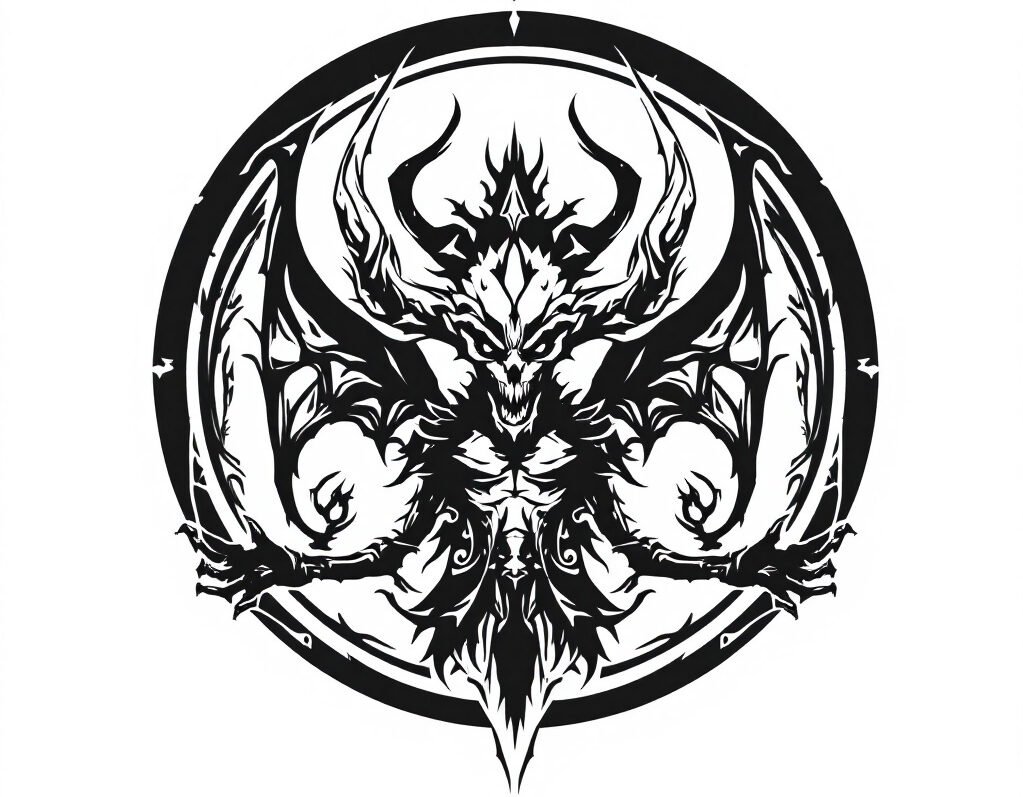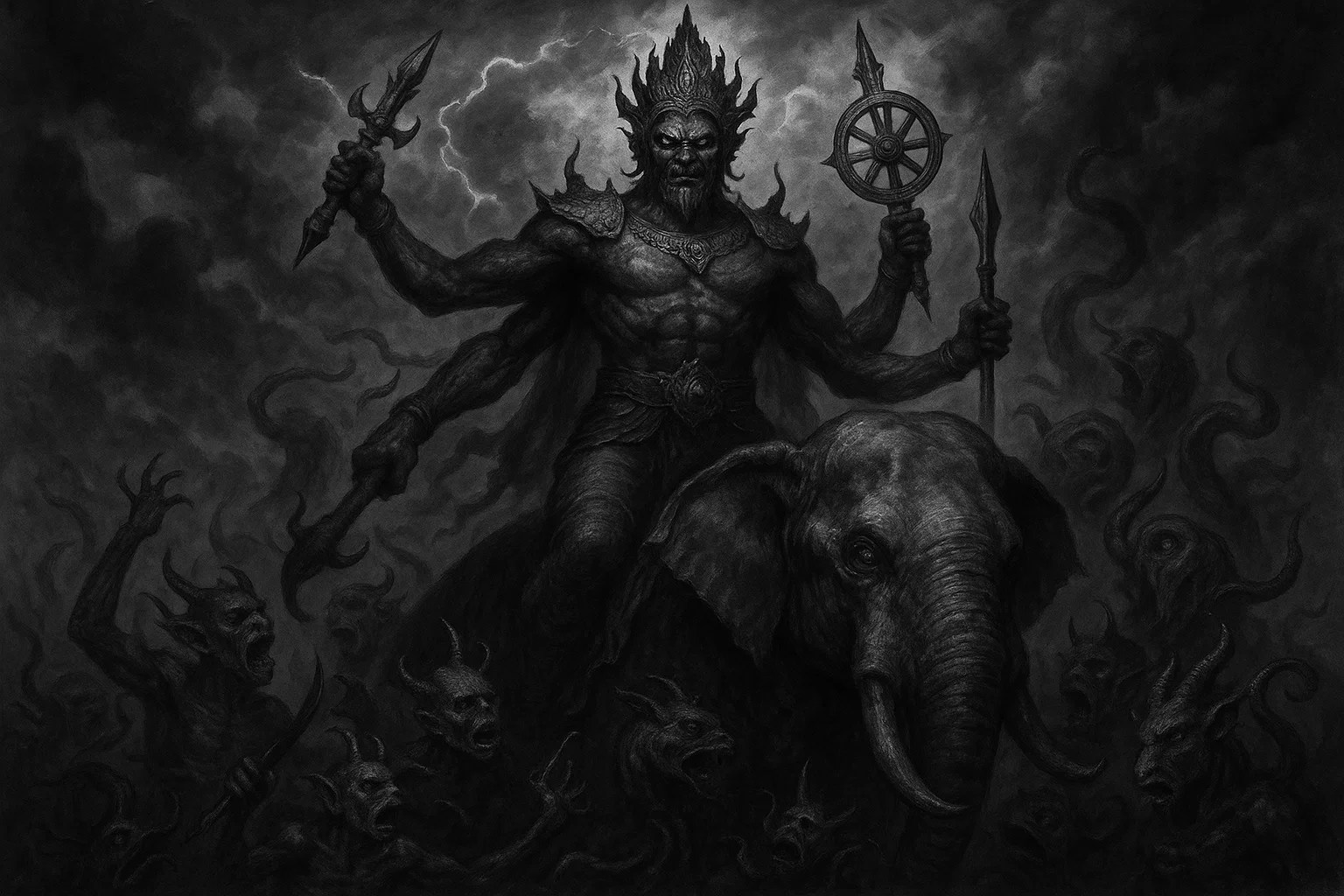Mara is an important demonic entity in Buddhist teachings. He stands as the main demon who attempted to prevent Siddhartha Gautama from attaining enlightenment. Known as the Evil One, he represents forces that block spiritual growth, such as desire, fear, and death.
In stories from ancient texts, Mara uses various tactics (such as armies of monsters and beautiful women) to lure people away from the path to freedom from suffering. His role shows how inner struggles can feel like outer enemies. But the Buddha overcame him through calm focus and insight.
While Mara originates from early Indian ideas associated with death, he evolved into a unique Buddhist symbol. He has some ties to Hindu concepts of death and evil (like those around Yama). For more information on similar figures, check the Hindu Demons category.
Summary
Key Takeaways
| Attribute | Details |
|---|---|
| Names | Mara, Māra, Papiyan, Namuci, the Evil One, Tiānmó (Chinese), Tenma (Japanese), bdud (Tibetan) |
| Title | The Evil One, Lord of Death, One Who Delights in Destruction |
| Region | India (origin), widespread in Buddhist areas like Tibet, China, Japan, Thailand, Sri Lanka |
| Type | Buddhist demon |
| Gender | Male |
| Realm | Desire realm (Kāma-loka), highest level called Paranimmita-vasavatti heaven |
| Obstacle/Threat | Temptation through desire, fear, doubt, and illusions that block enlightenment |
| Associated Figures | Gautama Buddha, Mara’s daughters (Taṇhā, Arati, Rāga), monk Upagupta |
| Weapon/Item | Armies of demons, illusions, wheel of destruction, daughters as temptations |
| Weaknesses | Overcome by meditation, insight, enlightenment, taking refuge in the Buddha |
| Associated Deity/Figure | Gautama Buddha, Upagupta |
| Pantheon | Buddhist, with Hindu influences |
| Primary Sources | Samyutta Nikaya, Lankavatara Sutra, Jingde Record of the Transmission of the Lamp |
“Mara” Meaning
The name “Mara” originates from ancient roots in the Sanskrit and Pali languages. It links to the word for death or killing.
In Sanskrit, it stems from “mṛ,” which means “to die” or “disappear.” This root is most obvious in words like “mṛtyu” (another term for death). Over time, Mara became a name for the force that brings an end and harm. In Buddhist stories, this aligns with his role as a barrier to life-changing insight. He stands for the end of spiritual progress, like a killer of good efforts.
In early texts from India—dating back to around 1200 BCE—Mara is mentioned as Mrtyu or Agha Mara, the evil slayer. This idea originated in Buddhism, where it evolved into a full-fledged concept. Here, the demon’s name is associated with sorrow, misery, and bad luck.
In China, the demon is known under the name Tiānmó (meaning “heavenly demon”). Japan calls him Tenma. Tibet uses the name Bdud (which also hints at evil forces). Korea has Mara as it is.
These shifts reveal how Buddhist ideas spread and merged with local practices. The name’s growth reflects Buddhist views on life cycles. Mara is not just a malevolent entity; he illustrates how desire and fear keep people trapped in the cycle of rebirth. In fact, even his title, Papiyan, means “one who is evil and linked to misfortune.”
Thinkers like Nyanaponika Thera saw him as the face of things against enlightenment. This makes his name a warning: watch out for inner traps that lead to spiritual death.
Overall, his etymology reminds us that death—in mind or body—is part of what we must face to find peace.
How to Pronounce “Mara” in English
Say it as MAH-rah. The first part sounds like “ma” in “mama,” and the second like “rah” in “hurrah.” In some places, it’s MAR-uh, like “mar” in “march” and “uh” like a soft sigh. For Chinese Tiānmó, it’s TYEN-moh. Japanese Tenma is TEN-mah.
What Does Mara Look Like?
Mara often shows up in art as a terrifying demon king. He has a fierce appearance, sometimes accompanied by wild eyes and sharp teeth. His body might be strong and tall, like a warrior.
In some pictures, he rides a huge elephant named Girimekhala, a black and massive creature, standing up to 250 yojanas high. In other depictions, he’s an enormous cobra or bull, ready to attack. He leads an army of hideous monsters: some with three heads, horns, or animal parts like owls and dogs.
In different Buddhist ways, his look changes. For example, in Theravada art from Thailand or Sri Lanka, he’s a hideous tempter with weapons, trying to intimidate the Buddha.
Reliefs from ancient Gandhara in Pakistan show him in human form, but evil and strong. Mahayana icons from China (like in Dunhuang caves) paint him with his daughters and demon troops, all colorful and wild. They tempt with beauty but turn frightening.
Vajrayana in Tibet might show him as a dark force, sometimes tamed into a protector. However, overall, the physical depictions are inconsistent across multiple sources.
To make things even more complicated, some sources say he can change shape: handsome to lure mortals, or monstrous to frighten. For example, palm leaf books from India depict their demons as twisted beings. However, in these stories, demons can use illusions, so their true form hides behind tricks.
You may also enjoy:
Who Is Abalam in Demonology? The Terrifying King That Serves Paimon
September 30, 2025
Aamon: The Infernal Marquis of Lust, Feuds, and False Prophecies
September 29, 2025
Vritra: The Dragon Who Swallowed the Sky in Hindu Mythology
October 7, 2025
The Ghul: The Flesh-Eating Demon of Arabian Folklore
October 1, 2025
Banasura: The Thousand-Armed Demon King
October 10, 2025
Who Is Agaliarept, the General of Hell Under Lucifer?
October 8, 2025
Origins
Mara makes his first appearance in ancient Indian texts, notably in the Atharva Veda (which dates back to between 1200 and 1000 BCE). In these early writings, he is referred to as Mrtyu (Agha Mara), a malevolent figure symbolizing death and eternal darkness.
This initial characterization closely associates him with Yama, the deity responsible for overseeing the realm of death and the afterlife.
As Buddhist philosophy evolved, Mara’s role expanded significantly. He transformed from a mere harbinger of death into a complex archetype—a tempter who obstructs the path to enlightenment.
His mythological framework is intertwined with figures from Hindu tradition, such as the Asuras (demigods representing chaos and opposition), Rakshasas (demonic entities often characterized as malevolent goblins), and Pisacas (flesh-eating spirits), collectively forming an army that symbolizes human greed, attachment, and suffering.
The spread of Buddhism from India into other regions solidified Mara’s significance in narratives concerning the Buddha.
Within the Pali Canon (a foundational Buddhist scripture), Mara is depicted as the antagonist who confronts Siddhartha Gautama beneath the Bodhi tree during his quest for enlightenment. This poignant story establishes Mara as the embodiment of desire and fear, the very obstacles that prevent individuals from achieving spiritual awakening.
Over time, additional texts (such as the Samyutta Nikaya) elaborated on this narrative by introducing his daughters, who personify various forms of craving: wanting, aversion, and passion.
In Mahayana Buddhism, Mara’s portrayal deepens even further, where he is recognized as a manifestation of the illusions that arise within the mind. As Buddhism spread to East Asia—particularly in China and Japan—Mara’s image began to merge with local ghosts and supernatural concepts. Yet, he retained his identity as a Buddhist demon.
Furthermore, the roots of Mara’s character can be traced back to pre-Buddhist influences, particularly Vedic traditions, which recognize him as the embodiment of death itself. However, while early interpretations present him primarily as a force of malice, Buddhism emphasizes the importance of overcoming internal obstacles that prevent spiritual growth.
In the Tibetan tradition of Vajrayana Buddhism, these forces are often conceptualized not as adversaries but as potential allies (or helpers) on the spiritual path.
Regional Variations
Mara looks and acts a bit different across Buddhist lands, shaped by local art and beliefs. In some places, he’s more terrifying; in others, a clever trickster.
| Region/Tradition | Appearance | Role |
|---|---|---|
| Theravada Thailand | Tall warrior, fierce face, rides elephant, army of monsters | Tempter during meditation, causes fear and doubt |
| Theravada Sri Lanka | Hideous demon, black hide mount, multiple heads on troops | Attacker of the Buddha, blocks enlightenment with desire |
| Mahayana China | Celestial king, beautiful daughters, demonic army in caves art | Deceiver in sense world, guardian of passion |
| Mahayana Japan | Giant form, sometimes chariot, illusion maker | Distractor from truth, enemy of dharma |
| Vajrayana Tibet | Dark force, serpent eyes, tamed in icons | Obstacle to overcome, sometimes turned protector |
Role in Buddhist Cosmology
In Buddhist worlds, Mara rules the Realm of Desire, the lowest of the three main levels. This includes six areas: hells, hungry ghosts, animals, humans, asuras, and gods.
He lives in the topmost Heaven, Paranimmita-vasavatti, where beings enjoy their immortality, but still suffer. Mara acts as king there, using power to keep others trapped in cycles of birth and death.
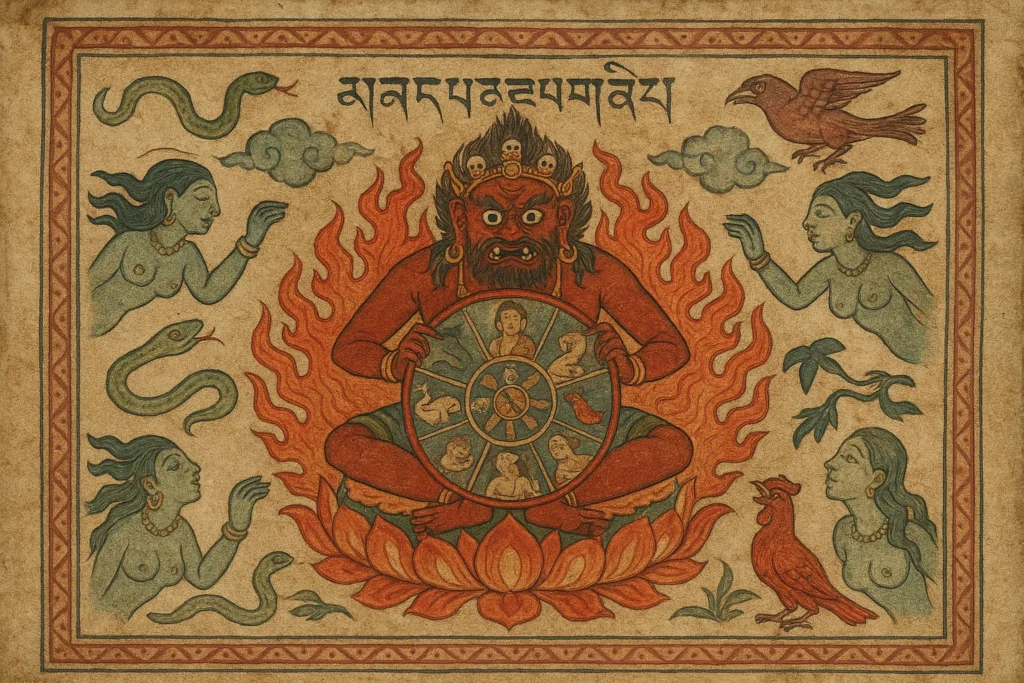
Mara in the Pali Canon
Mara plays a big role in the Pali Canon as the tempter who fights against awakening. In the Samyutta Nikaya, a section called Mara-samyutta recounts his clashes with the Buddha and monks. He uses tricks to distract, but always fails against true insight.
| Source | Quote |
|---|---|
| Sutta-nipata, Padhaana Sutta (vv. 425 ff.) | “O you are thin and you are pale, And you are in death’s presence too; A thousand parts are pledged to death, But life still holds one part of you.” |
| Samyutta Nikaya 4.1 | “You’ve wandered through the long course Creating beautiful and hideous shapes.” |
| Samyutta Nikaya 4.25 | “They had come to him glittering with beauty – Taṇhā, Arati, and Rāga – But the Teacher swept them away right there As the wind, a fallen cotton tuft.” |
| Majjhima Nikaya 50 | “Come out, Evil One! Come out, Evil One! Do not harass the Tathagata, do not harass the Tathagata’s disciple, or it will lead to your harm and suffering for a long time.” |
| Samyutta Nikaya 3.195 | “Mara = five khandhas.” |
| Sutta-nipata 3.2 | “For seven years I followed the Lord step by step but did not find an opportunity to defeat that mindful Awakened One. A crow flew around a stone having…” |
| Digha Nikaya 2 | “Mara is continually, ceaselessly, hovering around you, [thinking,] ‘Perhaps I’ll get an opportunity…'” |
| Samyutta Nikaya 35.115 | “He has gone over to Mara’s camp; he has come under Mara’s power.” |
| ThagA.ii.16 | “pancannam pi Maranam vijayato jino.” |
| SNA.i.44 | “Māro ti Vasavattibhūmiyam aññataro dāmarikadevaputto. So hi tam thānam atikkamitukāmam janam yam na sakkoti tam māreti, yam na sakkoti tassa pi maranam icchati, tenā Māro ti vuccati.” |
| Samyutta Nikaya 23 (Radha Sutta) | “Anything that perishes, says the Buddha, such as body, feeling, perceptions, etc.” |
Mara in Mahayana Sutras
Mara appears in Mahayana texts as a deceiver associated with the illusions of the mind. In works like the Lankavatara Sutra, he’s part of what blocks one from seeing one’s true nature. These sutras stress overcoming him through wisdom that sees emptiness.
| Source | Quote |
|---|---|
| Lankavatara Sutra | “Then Mahamati said to the Blessed One: You have spoken of an astral-body, a “mind-vision-body” (manomayakaya) which the Bodhisattvas are able to assume, as…” |
| Mahaparinirvana Sutra | “Any such sutras and vinayas are the sermons of the Tathagata. One who follows what Mara says is kindred to Mara; anyone who follows what the Buddha says is a great Bodhisattva.” |
| Mahaparinirvana Sutra | “When one fears the four Maras and the evil-minded hunter, one takes the three Refuges [in Buddha, Dharma and Sangha]. As a result of the three Refuges, one gains peace. Gaining peace is true emancipation. True emancipation is the Tathagata. The Tathagata is Nirvana. Nirvana is the Infinite. The Infinite is the Buddha-Nature. Buddha-Nature is definiteness. Definiteness is unsurpassed Enlightenment.” |
| Lotus Sutra (Chapter 6) | “Because he always teaches the unexcelled way, He will be called Universal Light. His land will be clean and pure. And all its bodhisattvas will be daring.” |
| Vimalakirti Nirdesa Sutra | “Mara disguised as Indra tempting with heavenly maidens.” |
Mara in Chinese or Korean Folklore
Mara is not mentioned in Jataka Tales. These stories focus on the Buddha’s past lives, with little on demons like him. Instead, Mara shows up in other Buddhist tales that spread to China and Korea.
Powers and Abilities
Mara ranks high among demons, stronger than many like yakshas or pretas, but below Buddhas. He rules the gods in his Heaven, with vast reach over senses.
Compared to Asuras (warriors) or Pisacas (eaters), his skills focus on mind tricks, not just brute force. He can shake palaces or create storms, but enlightened ones can defeat him easily.
- Create huge armies of terrifying beings to attack.
- Create illusions of beauty, fear, or desire.
- Change shape into handsome or monstrous forms.
- Causes doubt and hesitation in meditators.
- Slip items like necklaces to trap people.
- Raise winds or tremble buildings with anger.
- Can send his daughters to tempt with craving and passion.
- Guard the sense world, blocking escape from cycles.
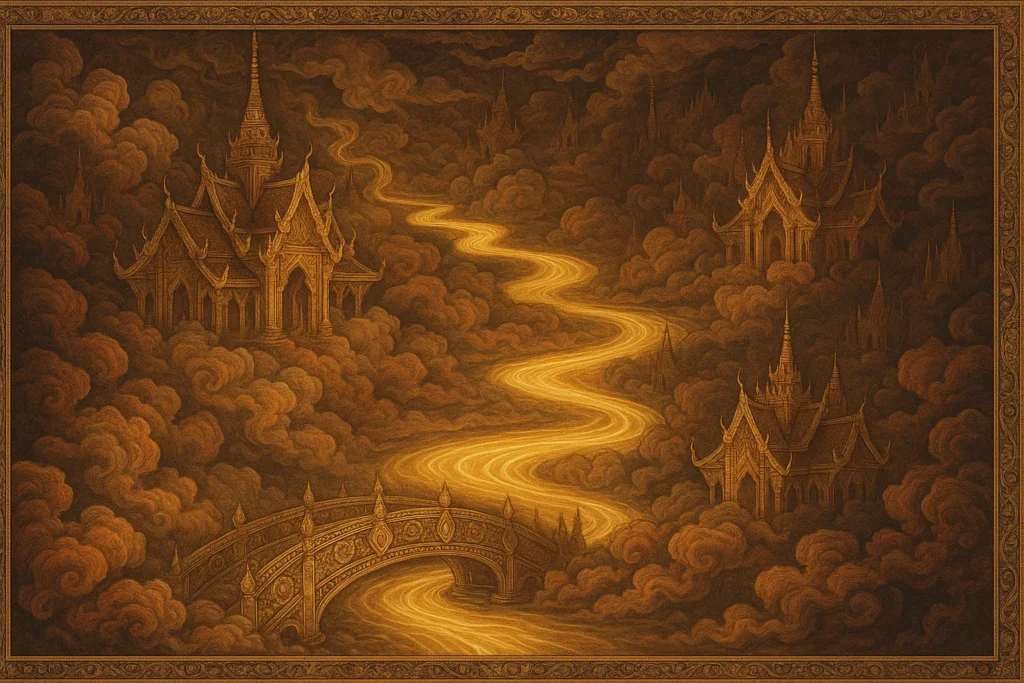
Mara Myths, Legends, and Stories
Mara’s Assault on the Buddha
As Prince Siddhartha sat under the Bodhi tree, close to achieving full awakening, Mara, the demon king, came to stop him. Mara brought his large army and showed visions of lovely women, who in tales are often depicted as his daughters.
However, in some versions, the daughters came on their own after Mara initially failed to do so. Mara’s three daughters are named Taṇhā (thirst), Arati (discontent), and Rāga (greed). They tried to lure the prince with their shine, but he stayed calm.
Mara sent waves of fear: rocks flying, dark clouds, loud roars. The army had twisted shapes—asuras, rakshasas, pisacas—with horns, multiple heads, animal bodies. They threw spears and arrows, but these turned to flowers near Siddhartha.
Mara claimed the throne under the tree was his and called his troops as witnesses. Siddhartha touched the earth, calling it to bear witness to his good deeds over many lifetimes. The ground shook, and goddess Earth rose to wash away the army with water from her hair.
Mara, angry, kept trying. He used wind to blow dust, but again, he failed.
Darkness fell, but light from Siddhartha broke it. The daughters danced and sang, using their youthful beauty, then later their age, to terrorize. But Siddhartha saw through: “Your tricks don’t work.” He swept them off like the wind blows cotton.
Mara fled, defeated. This win led to the Buddha’s full insight at dawn. Statues illustrate this with the earth-touch pose, where the hand is on the ground, calling witness against Mara.
You may also enjoy:
Who Is Jann in Islamic Mythology and Why Is He Feared?
October 2, 2025
Iblis, the Jinn King of Darkness and Deception
September 29, 2025
What Is the Abumi-guchi Yōkai and Why Does It Wait Forever?
October 22, 2025
Who Is Agaliarept, the General of Hell Under Lucifer?
October 8, 2025
Who Was Mahishasura, the Buffalo Demon Slain by Goddess Durga?
October 3, 2025
Who Was Hiranyakashipu, the Demon King of Hindu Mythology?
October 6, 2025
Mara’s Conversion by Upagupta
The monk Upagupta journeyed to the prosperous kingdom of Mathura, where he diligently taught the profound principles of Dharma to the eager hearts of the people. His teachings resonated deeply, causing a tremor in the very palace of Mara, the embodiment of temptation and ignorance.
Enraged by the impact of Upagupta’s wisdom, the demon king summoned his malevolent powers to undermine the monk’s teachings.
As Upagupta entered a profound state of meditation, enveloped in serene stillness, the demon approached him stealthily. In an attempt to distract and bind him, the demon placed a heavy jade necklace around his neck, a symbol of worldly attachment and suffering.
In a surprising turn of events, Upagupta skillfully transformed the seemingly lifeless forms of a deceased man, a dog, and a snake into an exquisite floral garland and presented this chain of blossoms to Mara. Initially, the demon was captivated by the beauty of the gift. Still, his delight quickly turned to horror as he realized its true nature—a reminder of the cycle of life, death, and rebirth.
Frustrated and desperate to rid himself of the necklace, Mara sought out Brahma, the lord of creation, pleading for assistance. However, Brahma explained that only the one who gave the necklace—Upagupta himself—had the power to remove its weighty significance.
Defeated, Mara returned to the realm of mortals, where he humbly bowed before the monk and expressed his remorse. Upagupta, embodying compassion, urged Mara to make a solemn vow never to cause harm to the Dharma again and to take refuge in the Three Jewels: the Buddha, the teachings, and the community.
Moved by this act of kindness, the demon accepted the monk’s counsel.
Mara’s Temptations
In one profound tale from ancient texts, Mara, the embodiment of distraction and temptation, attempted to sway the Buddha after he had achieved enlightenment. Cloaked in persuasive charm, he approached the Buddha, suggesting he assume the role of a powerful king instead of pursuing a path of teaching.
However, the Buddha firmly rejected this proposition, stating that his true purpose was to guide all beings towards liberation and freedom from suffering.
In another encounter, Mara unleashed a more devious tactic by sending his alluring daughters to tempt a solitary monk meditating in the forest. Disguised as enchanting young women, they offered him delicious food and the promise of carefree pleasure.
Yet, the monk remained steadfast and discerning, seeing through their enticing façade and recognizing them as mere illusions designed to lead him astray.
Mara also resorted to more sinister methods, such as conjuring a violent storm to instill fear among a group of devoted nuns. Undeterred, the nuns chanted their protective verses, their faith and unity dispelling Mara’s ominous presence until he ultimately retreated.
Mara’s influence extended beyond individuals; he sought to disrupt groups and communities as well. For instance, during times when the teachings of the Buddha began to spread widely, Mara instigated conflicts and fostered a sense of lethargy among followers.
However, enlightened leaders recognized his tricks, rallying their communities to remain steadfast in their pursuits despite his efforts to create division.
In a later legend, Mara assumed a more insidious guise, posing as a friend to a diligent seeker seeking guidance. Offering misguided advice that led the seeker away from the path of enlightenment, Mara nearly succeeded in his deception.
However, upon consulting a wise mentor, the seeker was shown the true nature of his “friend”—Mara himself. With this newfound clarity and right perception, the seeker was able to dispel the trickery that had clouded his understanding.
In yet another story, Mara confronted an elderly monk, taunting him with the thought that it was too late for him to achieve enlightenment due to his advanced age. The wise monk simply responded with laughter, proclaiming, “Age means nothing when it comes to insight.”
At that moment, the weight of Mara’s presence diminished, and he vanished from sight, powerless against the monk’s unwavering wisdom.
Mara vs Other Buddhist Demons
| Demon Name | Associated Obstacle/Role | Origin/Source | Key Traits/Powers |
|---|---|---|---|
| Yama | Judge of hell, death bringer | Pali Canon, Mahayana sutras | Blue skin, bull mount, decides rebirth |
| Mahakala | Protector, time destroyer | Vajrayana texts | Black body, multiple arms, eats ego |
| Vaisravana | Wealth guardian, north king | Mahayana sutras | Golden armor, mongoose spits jewels |
| Hayagriva | Wrathful knowledge | Vajrayana tantras | Horse head, red body, crushes obstacles |
| Palden Lhamo | Fierce protector | Tibetan folklore | Blue skin, mule ride, drinks blood |
| Preta | Hungry ghost, endless want | Pali Canon | Thin neck, big belly, eternal hunger |
| Asura | Jealous warrior | Pali Canon | Fight gods, super strength, envy |
| Yaksha | Nature spirit, sometimes guard | Jataka tales | Club weapon, shape shift, protect trees |
| Rakshasa | Man-eater, night prowler | Mahayana sutras | Horns, eat flesh, illusion create |
| Pisaca | Corpse devourer | Early texts | Deformed, spread disease, fear induce |
| Kumbhanda | Pot-bellied dwarf | Vinaya Pitaka | Guard directions, cause madness |
| Vetala | Spirit possessor | Folklore | Hang in trees, riddle ask, body control |
| Bhuta | Ghost of dead | Abhidhamma | Unsettled, haunt places, unrest cause |
| Nagas | Serpent beings | Mahayana sutras | Half snake, water control, treasure guard |
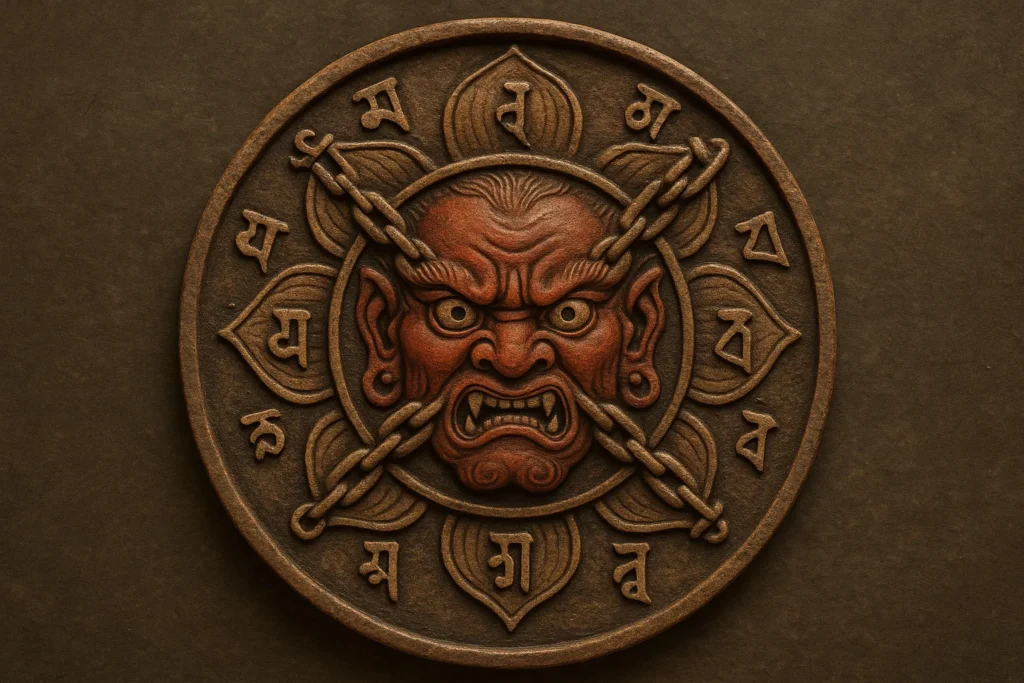
Mystical Correspondences
| Attribute | Details |
|---|---|
| Planet | Venus |
| Zodiac Sign | Scorpio |
| Element | Fire |
| Direction | South |
| Color | Red |
| Number | 4 |
| Crystal/Mineral | Ruby |
| Metal | Copper |
| Herb/Plant | Lotus |
| Animal | Serpent |
| Trait/Role | Temptation |
Mara is connected to Venus, the planet associated with love and desire, which reflects his ability to entrap souls through temptation. This cosmic connection suggests that the influence of stars can reflect our inner struggles. While Venus shines warmly, it can also conceal Mara’s tricks, guiding us away from a clearer path.
The Scorpio zodiac enhances this idea, as its intense nature aligns with Mara’s stealthy tactics, marked by passion and transformation. From the gentle allure of Venus to the sharp sting of Scorpio, we see a blend of charm and danger in Mara’s ways.
The element of fire represents Mara’s illusions, like a bright flame that can obscure our clear thinking.
The south direction, characterized by heat and brightness, symbolizes his connection to our senses.
The color red embodies themes of blood, anger, and desire—warning signs of what Mara brings.
The number four is significant, representing Mara’s four forms: emotions, death, existence, and divine beings.
Ruby gemstones, renowned for their strength, help us confront deceptive realities. At the same time, copper, associated with Venus, is utilized in rituals to resist temptation.
The lotus flower grows beautifully from muddy waters, symbolizing resilience against Mara’s desires. The serpent, with its cunning ways, mirrors the twists and turns of Mara’s influence.
Mara’s Symbols & Symbolism
Mara has key symbols in texts: his throne under the Bodhi tree, which he claimed but was won by truth. His armies stand for outer chaos; daughters for inner wants. The wheel of destruction spins cycles of pain.
In mindfulness, Mara warns of distractions: doubt, boredom.
Interactions with Practitioners
According to ancient Buddhist texts, the Buddha himself imparted a powerful lesson on how to confront Mara: by treating him as a guest rather than an adversary, we acknowledge the presence of these challenges with equanimity rather than hostility.
Monks, in their disciplined practice, navigate these temptations by cultivating calmness and recognizing that the desires embodied by Mara are fundamentally empty—fleeting thoughts that hold no genuine value.
Instead of forcefully dismissing these intrusive thoughts, they adopt a mindful observation technique, allowing the thoughts to flow by like clouds in the sky. By naming these distractions as “Mara” during meditation, practitioners create a mental space that enables them to acknowledge the challenges without becoming ensnared by them.
Buddhism offers various techniques to support practitioners on this journey, such as chanting, which serves to center the mind and create a sense of communal connection, as well as the taking of refuge vows, which commit individuals to their spiritual journey and provide a framework of guidance.
You may also enjoy:
Banasura: The Thousand-Armed Demon King
October 10, 2025
Who Was Hiranyaksha, the Golden-Eyed Asura?
October 7, 2025
Who Is Agares, the Demon of Earthquakes and Deception?
October 13, 2025
Who Are the Yaksha, and Why Did Buddhists Fear Their Wrath?
October 20, 2025
What Is the Abumi-guchi Yōkai and Why Does It Wait Forever?
October 22, 2025
What Is Qarin and Why Does It Follow Every Human Being?
October 8, 2025
